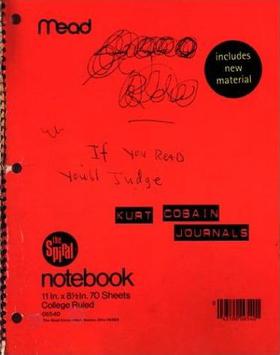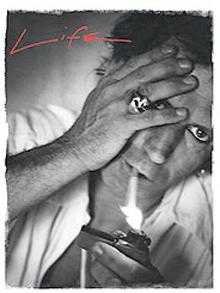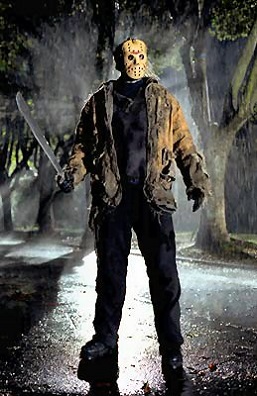
Kurt Cobain, the front man of the groundbreaking 1990s Seattle grunge band Nirvana has been considered the “spokesman for a generation” though his fame only lasted for roughly two and a half years before his inevitable 1994 suicide. His music was revolutionary and his fashion quickly became imitated by the mainstream, but Cobain was far from worthy of adulation. He was an extremely troubled person. He was depressed and angry, narcissistic, hateful, antisocial, poorly educated, hypocritical and self destructive with a major drug addiction, but a knack for writing catchy tunes.
I’ve always liked Nirvana’s music, but I’ve never cared much for Cobain as a person. I did eventually acquire all five Nirvana albums, but I have never worn their t-shirt. I say this to illustrate that I’m not just some Nirvana hater. I can separate the man from the music, and this article is about the man as he chose to present himself, his thoughts, ideas and values in his own words. I just don’t think there is much to admire about Kurt Cobain outside of his musical success. That was my opinion at the height of his fame, and after reading his “Journals,” published in 2002, that opinion wasn’t changed. It simply provided more evidence and details to confirm my earliest thoughts.
The Positive
I’ll begin with a positive note regarding what was admirable about Cobain. He was driven and he did seem to have a plan which he followed unwaveringly to eventual commercial success. He did what a lot of musicians and bands don’t do but should; he wrote out his vision for Nirvana. He crafted his business mission statement as it was – he thought out his distinct musical identity, his image and the values he wanted to project. He clearly identified his influences and what he wanted to influence his music. He wrote out steps and tactics in his journals. He thought about distribution, exposure, and reaching fans in an era before the internet made this much easier. He didn’t just do this once; as time went by he revisited and revised his plan as he figured out more about his tastes, styles and abilities instead of just drifting aimlessly in a chaotic musical landscape. Sadly, however this one paragraph is all that I found admirable in Cobain’s journals. The rest of his character was tragically flawed, and ventured into dark and evil places.
Obsessed with Grief
The most noticeable character trait displayed in Cobain’s journals is his overwhelming obsession with grief. His early preoccupation with suicide is evident by page 5, written no later than 1989, exclaiming “kill yourself,” a sentiment that is repeated multiple times throughout the Journals. He was fixated on everything “bad” to the point it seems he had no room left in him for joy. He hated everything. He hated himself. He was ashamed to be white, ashamed to be male, and ashamed to be American. I think this grief and self-hatred is the root of all his many other issues. When a person hates himself it leads to an inability to enjoy anything. It leads to nihilism, self abuse and eventually if left untreated to complete self destruction. Kurt Cobain eventually became dark, uninspired, and hopeless.
Obsessed with Division
Cobain was obsessed with creating division in the world. Though he portrayed himself as an advocate for love, tolerance and inclusion, it’s obvious he thrived on strife and division. He was especially preoccupied with creating division between the generations. This seems to originate from his personal issues with his own parents and upbringing. He wasn’t satisfied with his own sense of isolation; he wanted everyone else to feel that isolation too. He hated his parents therefore everyone of his generation should also hate their parents. Misery loves company.
Rape Fetish
Cobain was obsessed with rape, conflating it with traditional masculine sexuality to which he claimed to be opposed. He mentions rape repeatedly. He even imagines himself as a rapist, and writes about a time in high school when he tried to take advantage of a young girl who was considered “retarded,” though supposedly undiagnosed. At a later point he decided it was Nirvana’s job to “teach boys not to rape.” Apparently his method was to write songs like “Polly” and “Rape Me” that are so ineffectual they sound as if they are romanticizing rape. He later acted perplexed when listeners didn’t comprehend these were supposedly “anti-rape” songs.
Between pages 90 and 95 Cobain wrote the most bizarre part of his journals, a story about a fictional serial murderer, rapist a child molester he named Chuck Taylor. Apparently Chuck became this monster due to his father’s influence. It includes a very graphic scene in which Chuck is forced to watch as his father beats, rapes and sodomizes his mother while extolling the virtues of being a “man” and abusing women. In another entry (pg 109) he says he likes to make incisions on an infants’ stomach and then “fuck the incision until the child dies.” It’s another peek into Kurt Cobain’s grotesque dysfunction.
I got the sense that Cobain had a rape and murder fetish that haunted him, contributing to his self-hatred. He related this to himself “as a man,” and projected that upon the idea of masculinity. Since he saw “right wingers” as representing traditional masculinity he could project his sickness and self-hatred onto them as an “other” thereby gaining a false sense of virtue and self-righteousness for hating them instead of addressing his own demons.
Hypocrisy, Self-delusion and Terrorist Advocacy
Hypocrisy was another of Kurt Cobain’s worst traits. In multiple entries, Cobain says that to him “punk rock means freedom.” It’s another recurring thought in his journals. This would seem to be a motive for his hatred for “right-wingers,” because he saw them as trying to restrict his freedoms through pro-life and other religiously based legislation. But he wasn’t very considerate of other people who chose to live in a manner in which he disapproved.
There are multiple entries in which Cobain expressly advocates for and glorifies Left-wing terrorism. Amongst the many examples of people Cobain said he wanted to kill, he wrote a disturbing passage describing how he wanted to go through high schools and put guns to the heads of popular kids and force them to renounced their “gluttonous” lifestyle or be killed (132). He didn’t write this as a frustrated teenager. He was a grown man well into his twenties expressing a desire to murder kids who simply used their freedom to make different choices than he made. Here, Kurt Cobain’s reoccurring hypocrisy is on full display in one of the most disgusting of ways.
Cobain’s writings also show a strange obsession with the KKK and outlandish caricatures of “right wingers” and misogynists. He really was a product of the west-coast’s socio-political atmosphere and ideology which helped warp him into someone who seemed to be barely clinging to his humanity.
Cobain’s self-delusion is most evident when he wrote about his place in the music industry. Of course he wanted to be successful as a musician, but he felt guilty for that so he tried to rationalize his ambition to fit his radical ideology. Rather than honestly admitting he was desirous of fame and fortune, he instead tried to portray his major-label aspirations as some form of punk-rock Trojan horse strategy. He liked to say he was working on the inside to “rot” and destroy the industry, while in reality he was sitting as the cherry on top of Geffen Records, raking in all that gluttonous money he wanted to shoot children for enjoying.
He liked to pretend that he was in polar opposition to the rockstar excesses of the 1980s, but that was really just his form of gluttonous stardom. He wasn’t the wild, pussy slaying, private jet flying party animal. Instead he portrayed himself as the neopunk rock star; prepackaged rebellion, and feigned social consciousness. He knew he was playing a role that didn’t align with his real identity, and he felt pressured by the image he constructed of himself. That kind of cognitive dissonance must certainly be hard to live with.
Lack of Depth
There was a common misconception in the 1990’s that Cobain’s lyrics were mystical script of otherworldly genius that had to be decoded in order to truly perceive their great depth. I never bought it. While I could enjoy the energy of his music, I always thought his lyrics were haphazardly written, sloppily thrown together into a reckless word-salad. In his journals and other interviews he clearly reveals that his lyrics were quite often retched out at the last minute or adlibbed onstage until something stuck. He was frustrated by people who tried to analyze his lyrics because he knew there was nothing there worth analyzing. Cobain’s lyrics seem disjointed and jumbled because they are disjointed and jumbled. He mumbled and slurred a lot of his words because it really doesn’t matter if you understand them. Don’t look for depth and insight in Cobain’s lyrics because there is none.
He Loved His Ignorance
One of the more disappointing aspects of Cobain’s personality is that he preferred to remain ignorant. He mentions repetitively that he is not particularly well educated, and the grammar, and spelling throughout his journals is evidence enough of this. He wrote “I purposefully keep myself naïve and away from earthly information because it’s the only way to avoid a jaded attitude” (pg 125). That’s just dumb. Cobain liked to have strong opinions that resulted in a radical ideology and violent attitude, but didn’t want to actually have the knowledge by which to evaluate those ideas. He preferred to keep his miseducated opinions that fueled his desire to murder children because it made him feel good. Kurt Cobain was an idiot.
To go along with his multiple displays of ignorance and irrationality, Cobain liked to disparage musicians who actually bothered to learn music. He specifically ridiculed Eric Clapton who not only helped to forge modern rock and roll, but also managed to survive the test of time even while battling the same vices (heroin) that Cobain was too weak to overcome. Cobain regurgitated the same clichéd wannabe punk rock jargon that music theory is “bullshit.” The irony seems lost on him when he also complains about not being a very prolific songwriter. He never made the connection that music theory gives a person more tools to work with to create more original music instead of rewriting the same song over and over again while feeling like a fraud. Cobain’s inability to write new, significant music after “In Utero” contributed to his final mental breakdown and eventual suicide. It’s an example of how Cobain consistently made decisions and embraced attitudes that lead him steadily down a path of self-destruction.
To his credit, I suppose, Cobain knew all this about himself and through all his ignorance, hypocrisy, self-deception, delusions and his antisocial personality he freely admitted it. He told us as much in his lyrics.
“I’m a negative creep”
“I’m a liar and a thief”
“I think I’m dumb”
“I hate myself and I want to die.”
Rooted in self-hatred, fear, ignorance, left wing politics and drugs every decision he made was another step toward his early suicide.
Maya Angelou said “When someone shows you who they are believe them; the first time.” Kurt Cobain showed us time and time over again. There is nothing there to be admired.












